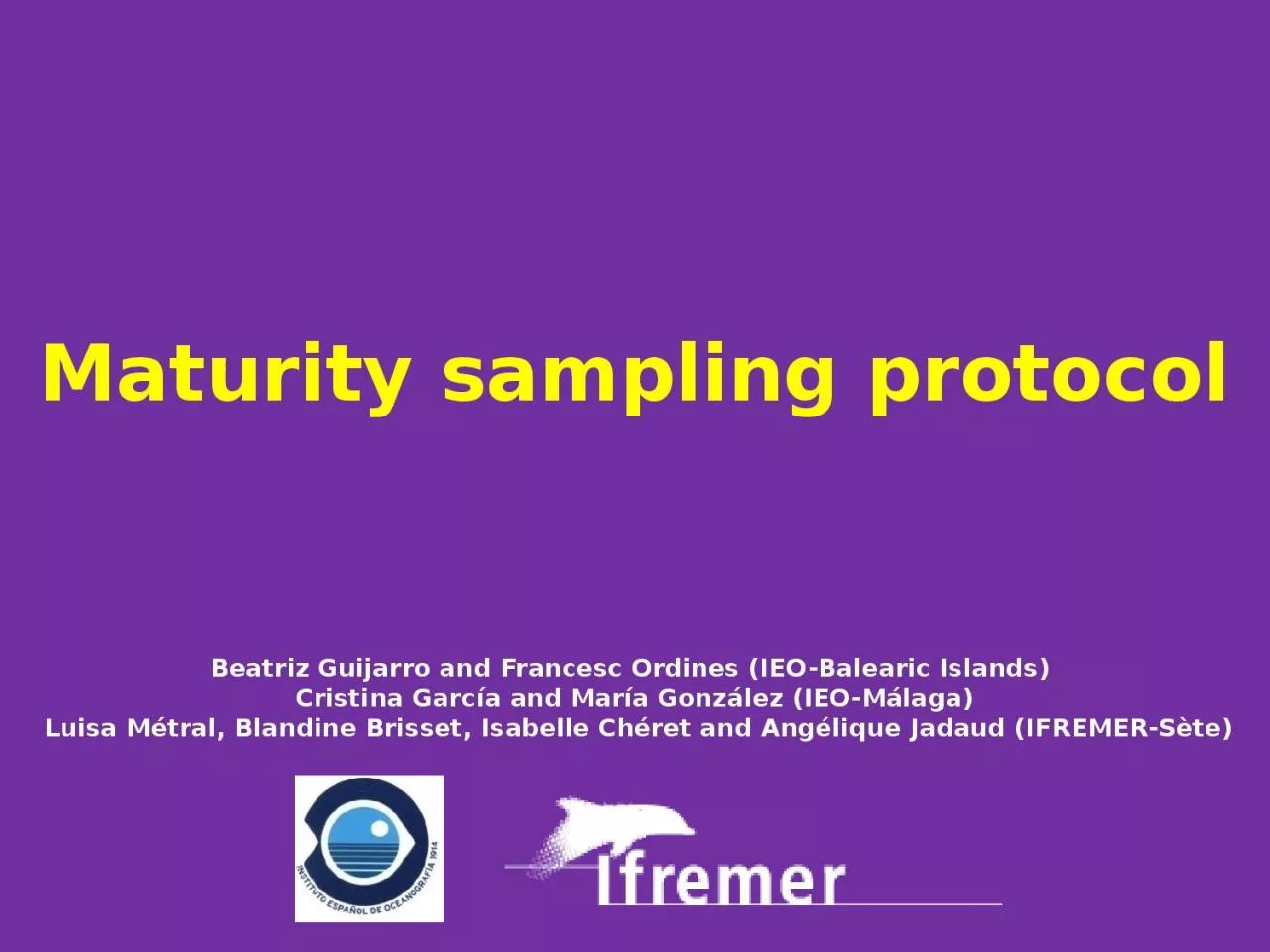

Beatriz Guijarro and Francesc Ordines IEOBalearic Islands Cristina García and María González IEO Málaga Luisa Métral Blandine Brisset Isabelle ID: 1042510
Download Presentation The PPT/PDF document "Maturity sampling protocol" is the property of its rightful owner. Permission is granted to download and print the materials on this web site for personal, non-commercial use only, and to display it on your personal computer provided you do not modify the materials and that you retain all copyright notices contained in the materials. By downloading content from our website, you accept the terms of this agreement.
1. Maturity sampling protocolBeatriz Guijarro and Francesc Ordines (IEO-Balearic Islands) Cristina García and María González (IEO-Málaga) Luisa Métral, Blandine Brisset, Isabelle Chéret and Angélique Jadaud (IFREMER-Sète)
2. Background: Problems found by MEDITS participants (ESP, FRA) for applying maturity stages from MEDITS handbook1. Potentially confusing stagesBony fish2aVirgin-developing*2bRecovering*4bResting*Elasmobranch oviparous2Maturing*4bRegenerating*Elasmobranch viviparous2Immature-developing*4bMature-Regenerating*Crustaceans1Immature= virgin*2aVirgin developing**2bRecovering**2eResting adult*Macroscopic analysisHistological analysis
3. 2. Definition based on COLOR and SIZEBoth options are subjective and species dependentFemalesSmall pinkish/reddish ovary shorter than ½ of body cavity. Eggs not visible by naked eye.VIRGIN-DEVELOPING2aPinkish-reddish/reddish-orange and translucent ovary long about ½ of the body cavity. Blood vessels visible. Eggs not visible by naked eye.RECOVERING2bPinkish and translucent ovary long about 1/3 of the body cavity. Eggs not visible by naked eye.RESTING4b
4. 2. Definition based on COLOR and SIZEBoth options are subjective and species dependentFemalesOvary hardy visible in transparence. After disection of the tegument ovary is small and lobes are flaccid, stringy and poorly developedWhitish or traslucidIMMATURE = VIRGIN1Ovary status to develop. Cephalic and lateral lobes are distinguisible by naked eye. Abdominal extension are thin and just visibleCreamVIRGIN DEVELOPING2aOvary status to re-develop. Cephalic and lateral lobes are distinguisible by naked eye. Abdominal extension are thin and just visibleCreamRECOVERING2bResting ovaryUncoloredRESTING ADULT2e
5. 3. Same definitions for different stages (ex. Crustaceans)FemalesOvary status to develop. Cephalic and lateral lobes are small but distinguishable by naked eye. Abdominal extension are thin and just visible.A. foliacea: flesh colored;A. antennatus: ivory colored with orange pink-violet dottingN. norvegicus: creamP. longirostris: cream orangeVIRGIN DEVELOPING2aOvary status to re-develop. Cephalic and lateral lobes are small but distinguishable by naked eye. Abdominal extension are thin and just visible. Occasionally presence of spermatophores in A. foliacea and A. antennatus.A. foliacea: flesh colored;A. antennatus: ivory colored with orange pink-violet dottingN. norvegicus: creamP. longirostris: cream orangeRECOVERING2bRe-develop: to develop something again
6. 3. Same definitions for different stages (ex. Crustaceans)Developing or re-developing??FemalesReference photos for “Developing/recovering” (Workshop on crustaceans maturity stages (19-23 Oct 2009, Messina, Italy). ICES CM 2009/ACOM:46
7. 3. Same definitions for different stages (ex. Crustaceans)MalesPetasma is not much visible, and there are not spermatic masses (emi-spermatophores) on the seminal ammpullae, located on side of the V pair of pereiopods. A. foliacea and A. antennatus: long rostrum.IMMATURE= VIRGIN*1Petasma appears visible and nearly or completely joined, but there are no spermatic masses in the seminar ammpullae. A. foliacea and A. antennatus: long or intermediate rostrumVIRGIN DEVELOPING**2aPetasma appears completely joined, but there are no spermatic masses in the seminar ampullae. A. foliacea and A. antennatus: short rostrumRECOVERING**2bPetasma is perfectly visible and completely joined. Spermatic masses in seminar ampullae. A. foliacea and A. antennatus: small rostrum RESTING ADULT*2dMale stages not applicable to N. norvegicus
8. 4. Confusion between immature and matureDepending on the group of species, “developing” is considered as immature (viviparous elasmobranchs) or mature (rest of groups).?
9. 4. Confusion between immature and matureDepending on the group of species, “developing” is considered as immature (Viviparous elasmobranchs) or mature (rest of groups).
10. Internal survey 16 IEO participants with experience in maturity sampling Five pictures: 2 fish (Mullus surmuletus and Merluccius merluccius) and 3 crustaceans (Nephrops norvegicus) Assign a maturity stage using MEDITS scales
11.
12.
13. Internal survey - ResultsX: none of these stageseggsP1P2
14. Internal survey - ResultsNA: no answer or more than one maturity stage assignedReference photos for “Developing/recovering” Workshop on crustaceans maturity stages (19-23 Oct 2009, Messina, Italy). ICES CM 2009/ACOM:46P3 P4 P5
15. Proposal Simplify confusing maturity sub-stages(at least for those MS which experienced problems in sampling)Bony fish012a, 2b, 4b2c34aCrustaceans012a, 2b, 2e2c2d3Elasmobranchs oviparous012, 4b3a3bElasmobranchs viviparousClarify immature vs matureCephalopodsOk
16. What is the objective of analyzing maturity in MEDITS?Maturity ogive & length at first maturity (indepedently or together with commercial information obtained)LengthPercentage of mature individualsL50
17. Conclusions Difficulty to discern sub-stages by macroscopic analysis maturity data may not be comparable when sampled by different teams Proposal simplify maturity stages by joining sub-stages which can be potentially confusing (reduce confusion and increase between-teams comparability) Further steps need to well define appropriate criteria (single species keys when needed, inclusion of reference pictures). What about using DCF WGs results, since the work is already done for some species?
18. guys please help me - is this dress white and gold, or blue and black? Me and my friends can’t agree and we are freaking the f*ck out